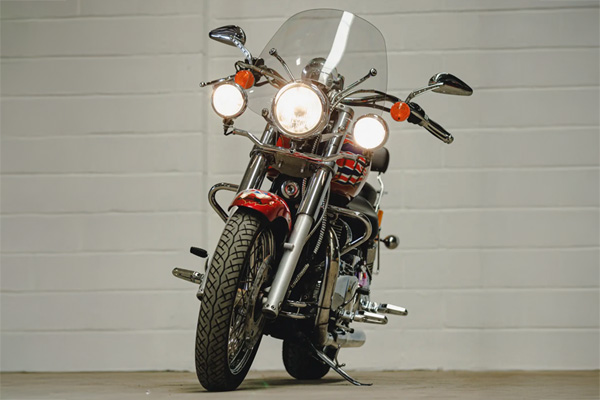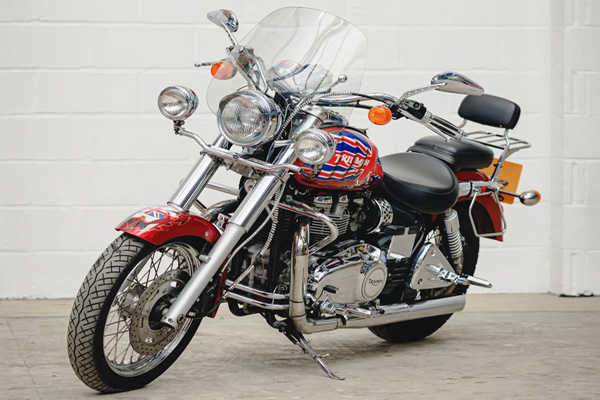Harley Davidson in the USA
Open-face helmet sunburn – just one challenges of classic bike renting and riding in the USA
Don't say it hasn't crossed your mind: renting a classic Harley-Davidson and taking in the sights and sounds road-tripping around California and Nevada.
Liam, not his real name, is a 46-year-old automotive business owner from "somewhere in England". He has an open-face crash helmet-shaped cherry-red glow to his face, is regretting renting a machine with a seat more suited to style than comfort, and frustrated that he had to fill up his "peanut" fuel tank every 100 miles or so in a country where distances are big, and sunny late-Spring/early-Summer temperatures are high.
We came across him in a hotel car park in Santa Monica. He and three mates had just ridden 270 miles from Las Vegas. Only one of them was smiling - laughing, in fact - because he'd selected a 2005 Yamaha Royal Star Tour Deluxe (as comfortable as it sounds), while another was flexing his aching wrists after choosing a 2006 Honda CBR600RR racer-alike, and rider four in the convoy was somewhere in between after booking a 2006 Triumph America.
![]()
But alarmingly and amusingly, while Liam's wife knows he's in the south west of the USA, and she knows he took his golf shoes and shorts, she doesn't know that his transport is a 2005 Harley-Davidson Sportster, and the itinerary involves far more V-twin iron riding rather than iron club driving.
"Everywhere is further than it looks," said Liam. "It's fair to say at least two of us would have chosen different bikes, and we'd have all been less ambitious about our road-trip route."
The bikes the guys selected from one of several motorcycle rental websites cost between around $30 and $60 a day. While dealers and specialist bike rental companies will all hire out new bikes, there's also a number of "bike share" sites from which privately-owned and quirkier classic bikes can be rented.

"We'd mainly stayed on the west coast, cruising between hotels and motels between San Francisco and Santa Monica, never more than 100 miles a day, and with temperatures around 18 to 20 degrees C, and mainly to get used to the bikes and the roads," said Liam.
"That was actually great. We saw a lot, and had a lot of fun, and met a few other bikers doing the same sort of stuff. But we learnt a lot in the process. Drivers in the USA, or California at least in our experience, are simply nowhere near as skilled or aware as in the UK or elsewhere in Europe we've road-tripped.
"The other thing is how few riders wear any proper protective gear. Whether it's to look cool or stay cool it was hair-raising to see how many riders were in shorts and T-shirts, even on the freeways. It made me wince a few times to see them weaving between lanes of traffic at high speed in a country not known for drivers who have great lane discipline.

"Having said that, getting through six-lane-wide solid standstill traffic in the Los Angeles rush hour took ages off our journey times, even if some bikers were overtaking us while we were riding pretty cautiously between the queues of traffic.
"There's other things to be aware of too: some aspects of driving and riding are completely contrary to what we've used to in the UK: simple things like getting used to street name signs hanging above intersections, or being allowed to turn right on a red light at most junctions .... but not all ... and fuel pumps being opposite to Europe: unleaded fuel hoses being black and diesel being green.
"But it's the distances that catch you out, especially when some roads are arrow straight for a hundred miles or more. Sometimes it may not feel particularly hot when you set out, but the sun can be very strong, and we were caught out a couple of times by sudden rain storms. Like most things in America, those rain storms don't do things by halves. The temperature change between the coast at, say, Malibu, and the other side of the mountains, for instance Woodland Hills - about 12 miles - can be 20 degrees C difference. That's difference, and within half an hour's ride.
"We had intercoms, which really helped on long runs - but everything we experienced meant we'd take a completely different approach to planning next time."

Liam and his friends' top tips for such a biking trip:
- Really swot-up on the USA's rules of the road; they can be very different from Europe, for instance, being allowed to turn red through a red light... but not all red lights. The only double-yellows on US roads are the central dividing line. Crossing them is a very serious driving offence. Parking? If the kerb is red don't expect to come back and find a mere parking ticket; your vehicle will be impounded. Make a turn or lane change without indicating, and if Police see you they'll stop you.
- And, seemingly, half of road users are ruthlessly move-over-after-overtaking-minded, while half are oblivious to the queues they generate.
- Pedestrians have absolute right of way. If you're turning through a junction and a pedestrian is about to cross - you stop. Some particularly bloody-minded pedestrians will even just step out regardless and without looking.
- So far as roads policing is concerned, the law is the law. You simply don't argue or try to negotiate with law enforcement if they stop you. Let them make the decision whether or not they're going to send you on your way with advice rather than a ticket. And bear in mind that getting off your bike or out of your car when stopped by law enforcement is considered to be a threatening action.
- Those big distances: make sure you know what you're getting in to; it's not unusual to travel in a straight line on an empty road for a hundred miles or more. What's more, 90-degree turns suddenly appear out of nowhere with little notice in terms of signage. And consult weather forecasts. Like everything else in the USA, weather can be big, whether sun, rain or wind.
- Get a dashcam/bike-cam. At worst, if involved in an accident then it'll confirm fault in a nation in which legal action is a national pastime; at best, it'll provide some comedic coverage of some of the road behaviour you'll witness.
"What we did learn is 'what a country'. I can see why so many Americans don't have a passport: there's simply so much to see without leaving the country - and personally, I think a bike is the best way to do it," said Liam.
It'll be interesting to see how he passes off his bike helmet shaped sunburn when he gets home...

COMMENT